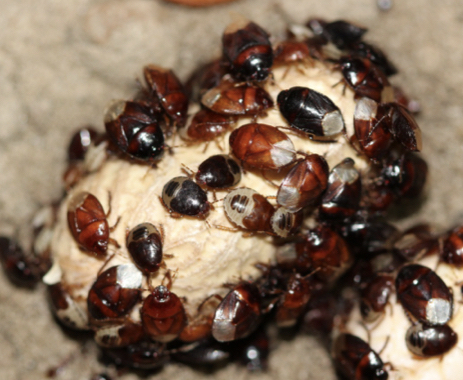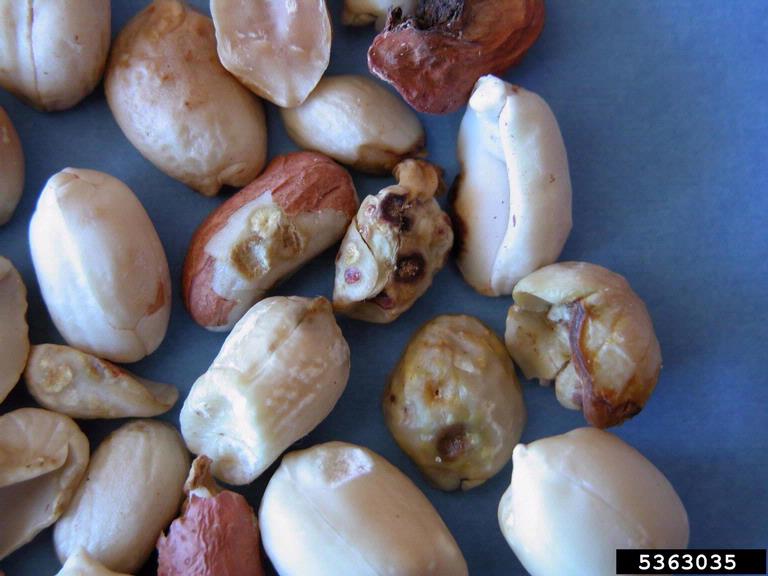Common Name: Peanut Burrower Bug
Author(s): Mark Abney, Benjamin Aigner, Entomologists, University of Georgia, 2022
Description
The peanut burrower bug is a sporadic but serious pest of peanuts in Georgia where nearly 50% of all US peanut production occurs. Recent increases in the prevalence of burrower bug damage in the Southeast US have highlighted the need for a greater understanding of the insect’s biology and ecology.
Immature stages: Eggs are oval-shaped, creamy-white in color and approximately 1mm in length. The head and thorax of nymphs range from light brown to black, and the abdomen is creamy-white to gray. Wing pads are present on the fifth instar.

Adult stages: Adult size varies considerably among field-collected specimens, but the average adult is approximately 5mm in length. Fully sclerotized adults are somewhat oval-shaped, shiny black and have strong, spine-covered legs. The sharp, deeply impressed line that runs parallel to the anterior and lateral edges of the pronotum serves as the primary diagnostic feature of PBB (photo below on right).

(Photo: Mark Abney, University of Georgia)

Biology
Life Cycle: Reproductive and developmental biology are poorly understood. In laboratory colonies, females deposit eggs singly in the soil, and first instars emerge within 7 days. At 29oC and 40% relative humidity a generation is completed in approximately 30 days in the laboratory. Recent studies suggest that similar generation times occur in the field in Georgia (May-Aug). Overwintering occurs in the adult stage, though nymphs have been observed in Georgia as late as mid-November. Adults are readily collected in light traps from May through September in South Georgia. Though sex ratio varies from month to month, females make up 60% of the population collected in light traps over multiple years. Primarily considered seed feeders, adults and nymphs also feed on root and stem tissue.
Distribution: Peanut burrower bug is native to North America and is widely distributed throughout the southeast U.S. It was first reported as a pest in Texas in the 1970s, and had not been specifically recognized as a pest in Georgia, which is the largest peanut producer in the U.S., until 2010.
Damage
Peanut burrower bug host range is not well documented, but it is known to feed on a variety of cultivated plants including spinach, strawberry, cotton, and peanut. The insect uses its piercing-sucking mouthparts to feed directly on developing peanut seed. Their mouths are like a hypodermic needle that pierces through the hull of the peanut to the seed — they suck the juice out of the seed, resulting in sunken, yellowish, brown or black lesions on the peanut seed, often multiplied due to repeated feedings. Damage can only be detected after peanuts are harvested and sent for processing, resulting in unexpected revenue loss. Feeding does not typically result in significant yield reduction, but rather produces lesions on kernels that lead to a reduction in quality grade. Injury on greater than 3.49% of kernels (by weight) results in a grade reduction and a loss in value of approximately $300 per ton.


(Photo: Steve Brown, University of Georgia, Bugwood.org)
Management
In the field, the bugs spend most of their time underground. Because they don’t feed above ground and live underground in the soil, it is difficult both to scout for the bugs and to target with an insecticide. No economic injury levels exist for burrower bug in peanuts, and there are no cost-effective methods for monitoring the pest. The only insecticide that provided consistent control in field settings was the granular formulation of the organophosphate chlorpyrifos; however, all food use tolerances for chlorpyrifos were revoked in early 2022. Cultural management tactics include the use of deep tillage and irrigation, but neither of these practices nor the use of insecticide provides complete control. Efforts are currently underway to develop a risk assessment tool to predict the occurrence of damaging populations.
Additional Resources
- Biology and Management of Peanut Burrower Bug (Hemiptera: Cydnidae) in Southeast U.S. Peanut
- Peanut Burrower Bug Poses a Complex Problem for Producers
Additional Bugwood.org Images

